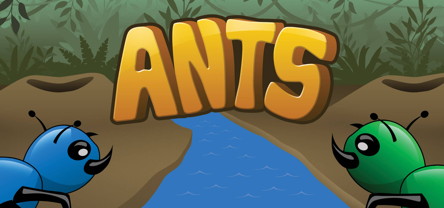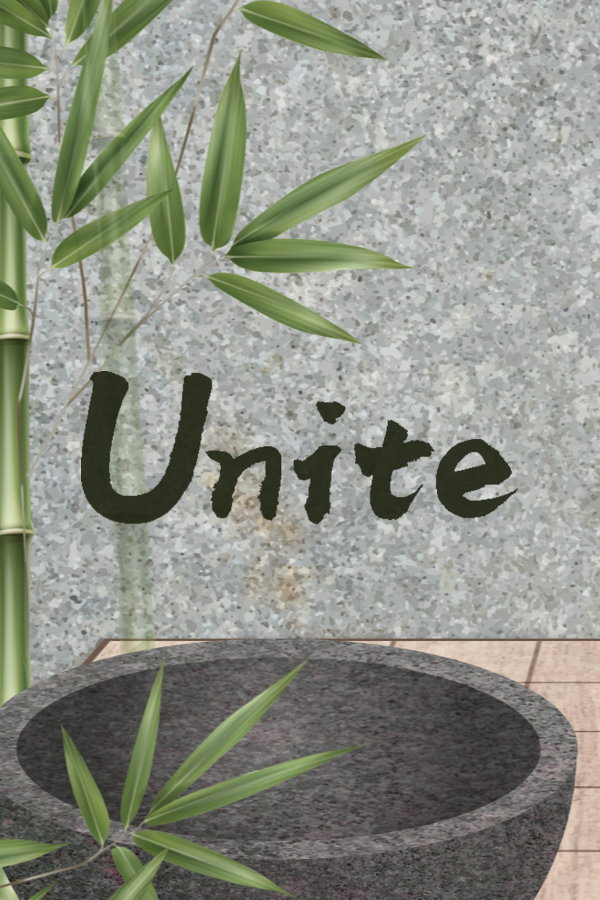|
After breakfast we started off on the High Road to Taos. The direct route to
Taos along Highway 68 is only about 45 minutes. But if you've got the time, you
should definitely take the High Road, which is basically NM 76. The road travels
through several mountain towns filled with artists galleries and other goodies.
Unfortunately for us, it was Sunday, and Mother's Day as well, which meant that a
lot of places were closed. But enough were open to satiate us for this trip. Our
first stop was the
Chimayo Trading & Mercantile store in the small town of Chimayo.
We were the only ones there for awhile and got personal service as we examined
Kachina dolls, pottery, and rugs. While we shopped, a busload of tourists came
into the store. We settled on a small Kachina doll (the one we REALLY wanted cost
close to $1000 dollars) and Jean found a decorative feather she liked. I asked
permission to take pictures of the store, and the woman said it was no problem, so I
took a few shots for posterity.
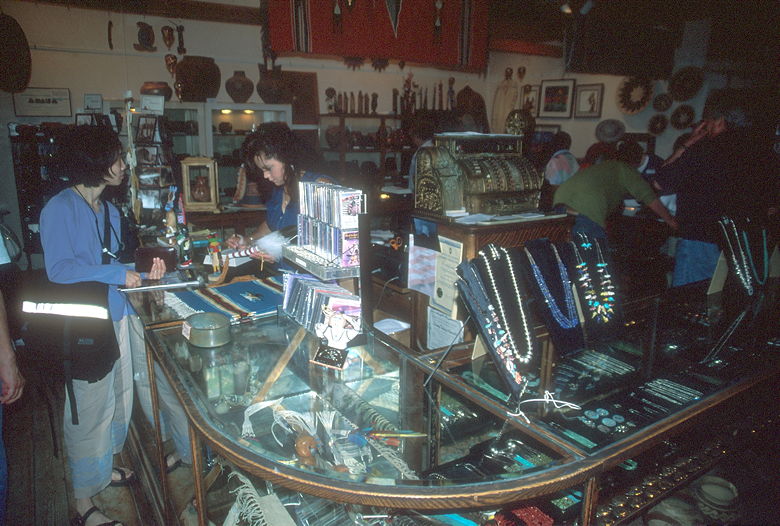
Chimayo Trading & Mercantile
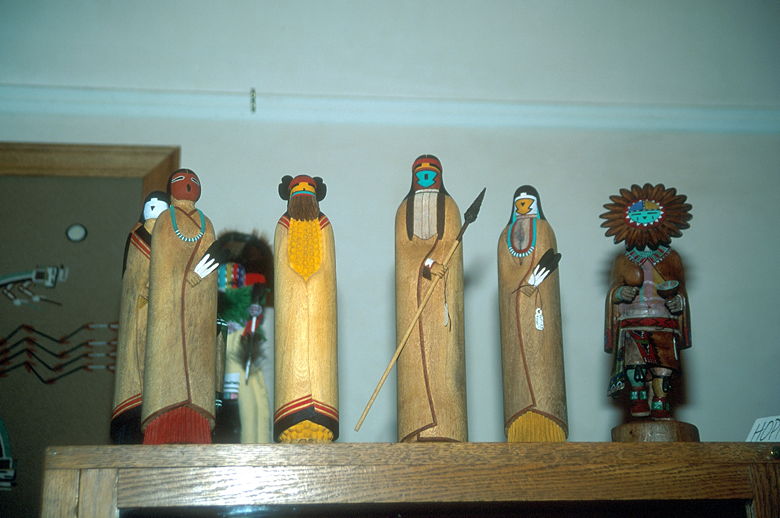
Kachinas
After the store, we continued up the road to El Santuario de Chimayo, which is
ascribed with miraculous powers of healing. However, they were having mass and we
decided not to enter. We observed from the outside and then continued along our way.
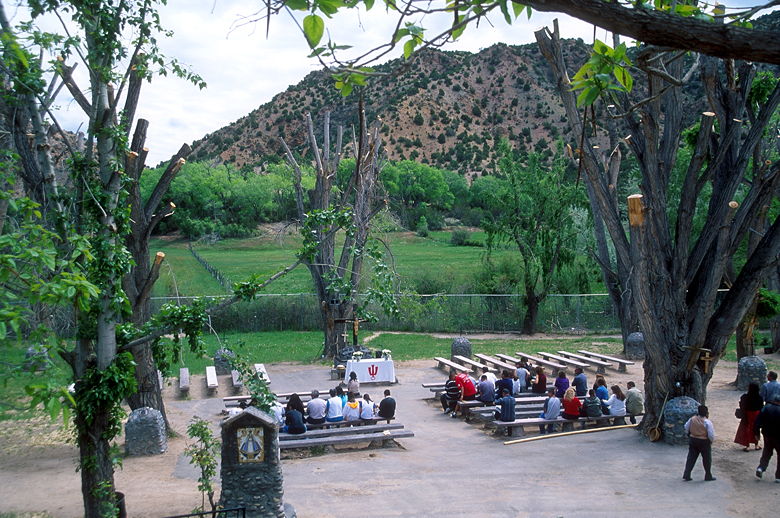
Outdoor mass at the church
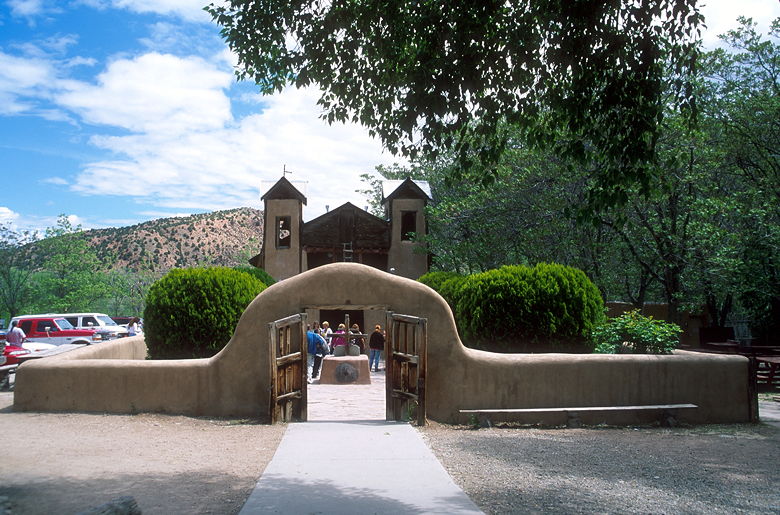
El Santuario
One annoying, common trait of the area is that every gallery and store has an "Open"
sign. This doesn't mean they're open -- it just means that they're too lazy to
change the sign to "Closed". We stopped at a couple places which said Open, only
to futilely knock on the door.
Feeling a bit hungry, we stopped at the Restaurant de Chimayo, which is next to
the church. Unfortunately, it was lunch time and Mother's Day, and they said it'd
be an hour's wait. We went to the bar to get some snacks, but they were too busy
to even take our order, so we left, disappointed and a bit miffed.
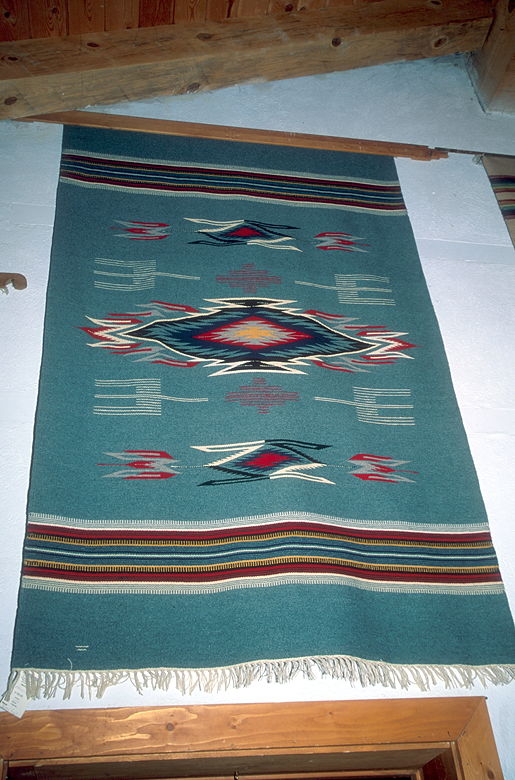
Rug in one of the shops
Our next stop was the
Oviedo Gallery. When we arrived, three dogs started barking furiously at us, and it wasn't clear
the gallery was open (despite the Open sign). Soon a woman came through a door and
told us to come in, however. The dogs left us alone and we walked through the
gallery of bronze sculptures. We especially liked three lizards (two green, one
black) attached to the wall above an arch. There were also sculptures of Kokopelli,
cats, mice, and other animals.
The next town is Cordova, where we stopped at two galleries. First, we stopped at the
Castillo Gallery. Paula Castillo is a painter, and Terry Ensenat Mulert is a wood carver. Both
their works are shown in the small gallery. Terry was there to talk with us about
his work. He explained that when he created something he wasn't happy with, he broke
off the head and collected these broken wooden heads. Then he placed them into a
nook in the side of the house, which is the first thing we saw when we arrived.
Terry's work is mostly twisting, narrow faces. Paula's work is whimsical.
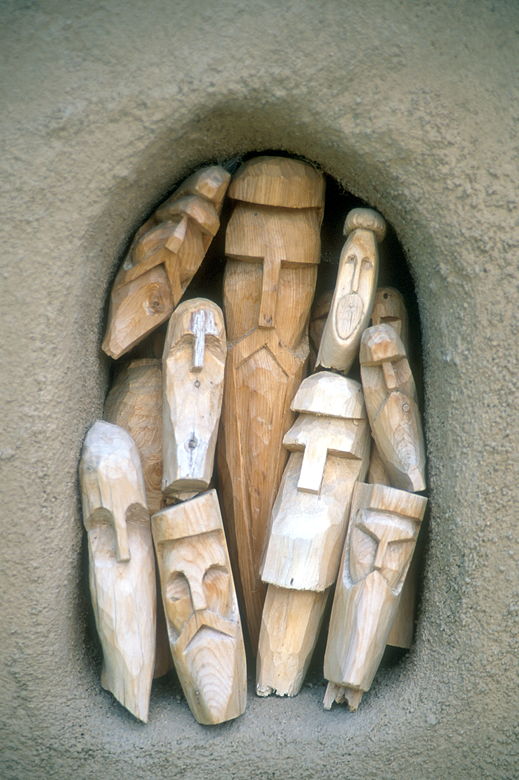
Wooden heads outside Castillo Gallery
We stopped at a local wood carver's studio briefly before continuing along the
High Road, in search of food. Unfortunately, we wouldn't find much -- there's not
much in the way of services along the road, and it being Sunday, the few we did find
were closed. We ended up having to wait until we got to Taos to eat.

Truchas
The next town is the amazing town of Truchas. Apparently this town was featured
in the movie The Milagro Beanfield War, though I'm surprised I don't remember much
scenery from the movie. The town of Truchas has an amazing view of green fields
with the sight of 13,101-foot snow-covered Truchas Peak in the distance. Old
decaying log cabins slide down the slopes of the town. It's not a particularly
inviting place -- any of the modern buildings aren't in great shape, either. But
the view just takes your breath away.
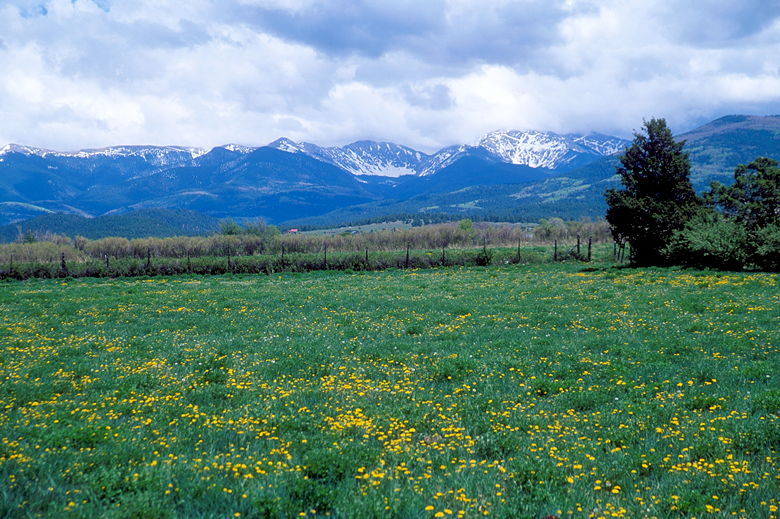
View near Truchas
We continued along NM 76, passing some poorer areas. We saw old pickup trucks on
blocks and dozens of abandoned, beat-up vehicles. We stopped briefly in Las Trampas,
where there is the San Jose Church. By this time we were starving, however, so we
quickly got back in the car and didn't stop 'til we made it to Taos, around 3:30pm.
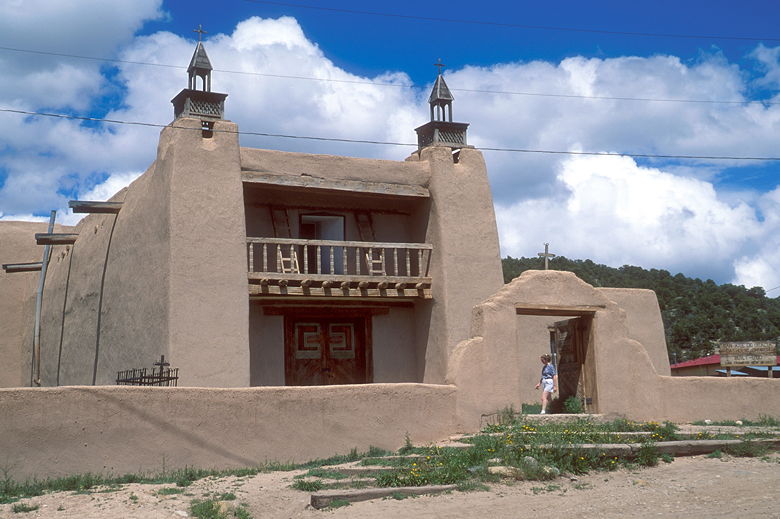
San Jose Church
Taos has fast food places, a Wal-Mart, and other modern conveniences (or intrusions,
depending on your point of view). It even has traffic, pretty much all from
tourists, of course. We parked and ate at the Taos Mountain BBQ. Afterwards we
continued up the road to the Taos Pueblo. We arrived at 4pm, just in time -- they
close at 5pm.
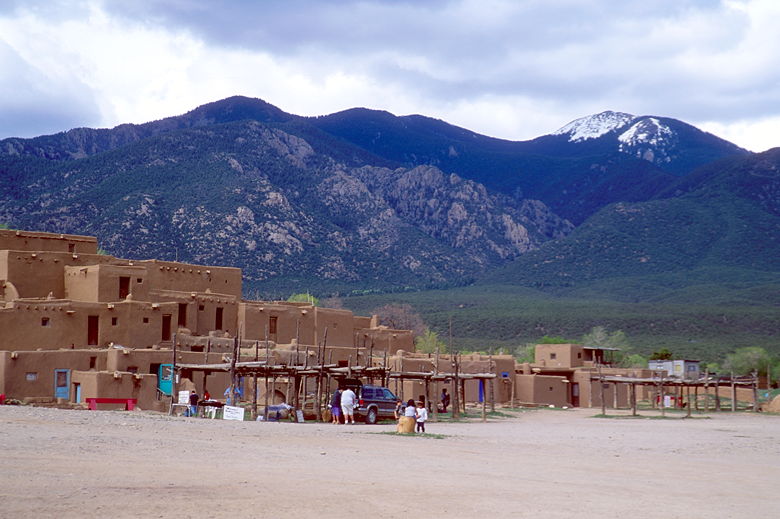
Taos Pueblo
The Taos Pueblo is the home of about 2,000 Taos Indians. They charge $10 per person
to enter the Pueblo, and $10 to photograph. Of course I paid the photography fee.
It's one of their sources of income, although I'm sure they make much more from
the Taos Casino down the road.
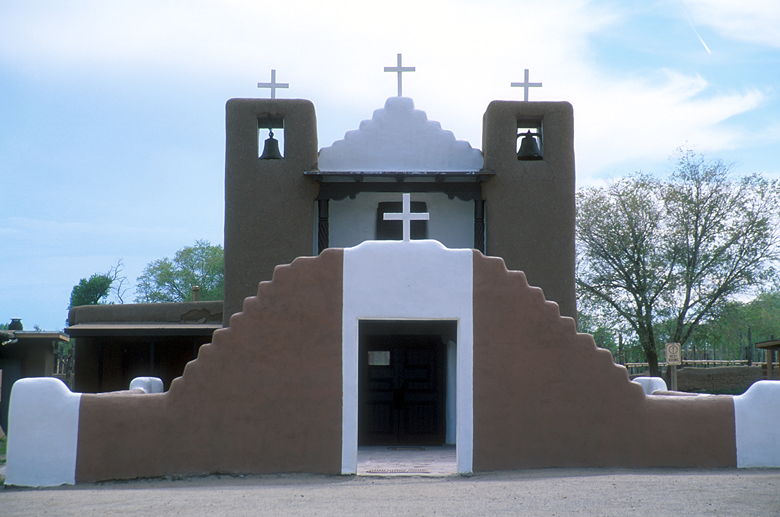
Taos Pueblo Church
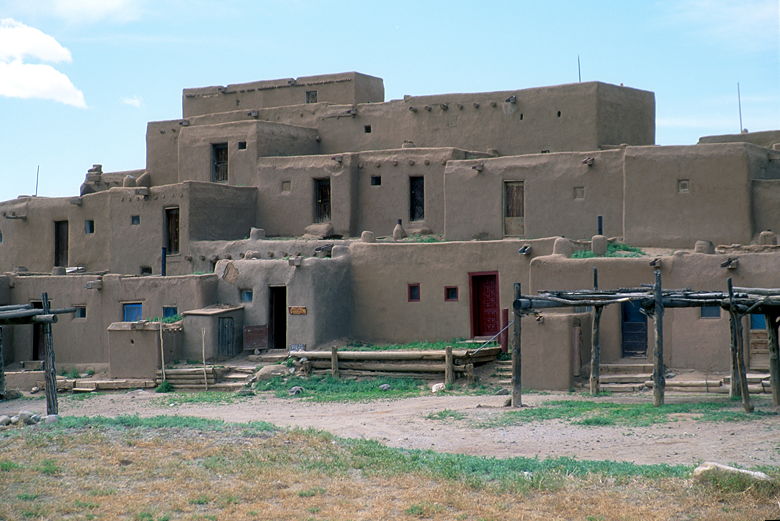
Taos Pueblo
The first thing you see when you enter the pueblo is the church, which is has a small
courtyard with a cross over the entrance. There's a wide open area, a creek running
down the center of the Pueblo, and adobe dwellings on either side of the creek. And
behind it all is the snow-capped peaks of Taos Mountain and friends. The mountains
in this region rise to as high as 13,000 feet.
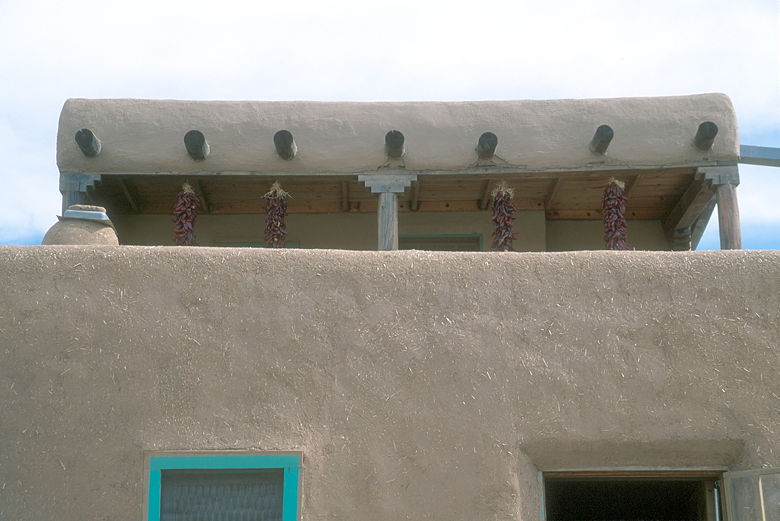
Peppers hung over a Taos Pueblo dwelling
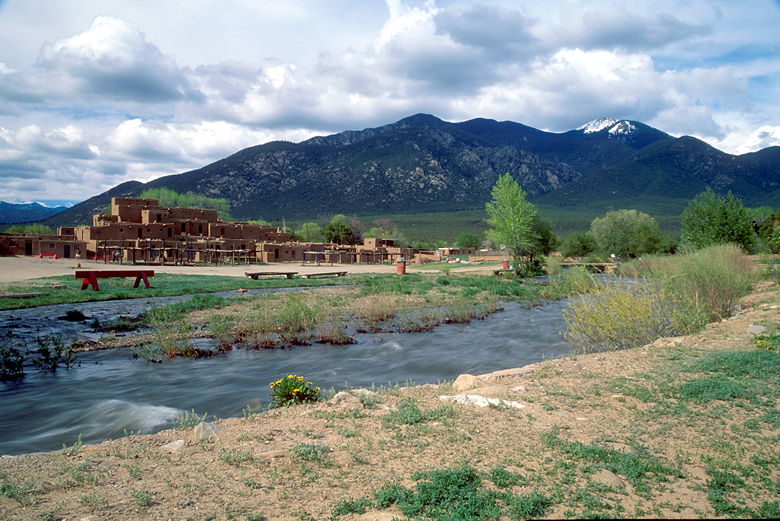
Taos Pueblo and their river
Back down to earth, most of the pueblo's residents were tucked away into their homes,
out of sight. Those that were visible were staffing small gift shops which were
present on either side of the creek. I had been hoping to photograph some of the
residents doing what they do, but I was to be disappointed. I did spy a couple
of the homes with propane tanks which they used to generate electricity. Apparently
200 of the residents still go without electricity or running water. The rest use
modern conveniences, however.
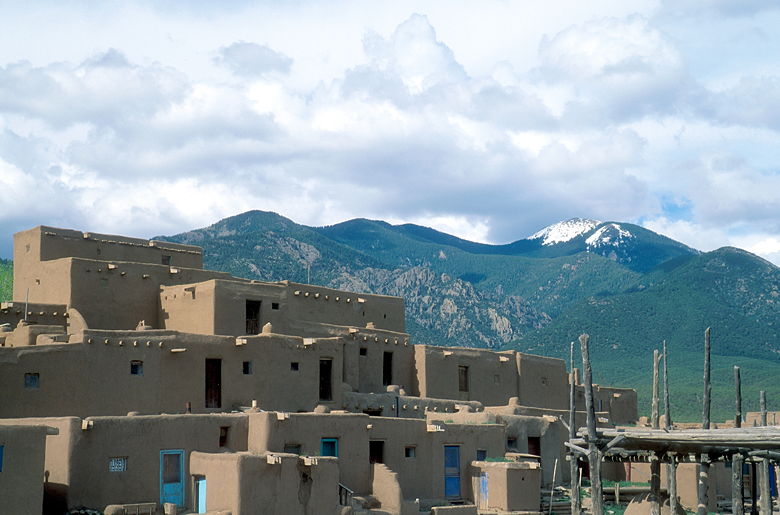
Taos Pueblo

Taos Pueblo Church cross
After visiting the pueblo, we retraced our steps back to downtown Taos and stopped
at the Taos Arts Festival. This was similar to all the arts & crafts fairs you find
in the Bay Area on weekends -- people set up under white tents selling their wares.
There were perhaps 40-50 booths, nothing special. I found it strange that after
traveling from Silicon Valley to northern New Mexico, everywhere I went I heard
people talking about technology. In the Restaurant de Chimayo I heard someone
talking about Epson printers. Here at the art fair, I heard people discussing
DVD-ROM, RAM, using cell phones. And everywhere I went, every place had a web
site. No restaurant or art gallery is too small to have a web site. The Internet
is everywhere. You can't escape it just by leaving Silicon Valley. But maybe
that's a good thing -- some of these artists probably greatly benefit from the
increased exposure and the chance to do research over the Internet. It's probably
even more important to them considering they live in small mountain towns, far from
large centers of population and modern services we take for granted.
In any case, after quickly browsing the art fair and being disappointed, we went on
to visit the Rio Grande River Bridge. More important than the bridge, though, the
drive to the bridge is beautiful. We realized that we were driving on a large,
mostly flat plain, surrounded by high snow-capped mountains to the north, south,
and east. It's a completely different world than the hot, dry, dusty world of Albuquerque
and Santa Fe. Whereas that area is mostly reds and browns, this area is all greens
and blues. In fact, the drive up the High Road to Taos consist of forests that look
as if they'd been transplanted from the Sierra Nevada. It is a beautiful place, one
I hope to return to in order to do some hikes in the mountains.
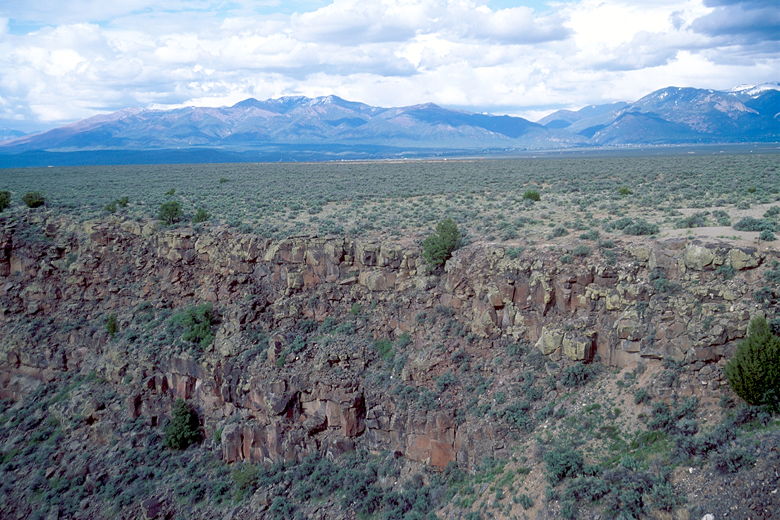
Rio Grande River Gorge and distant mountains
For now, though, we parked our car and slowly walked across the bridge. It was a bit
windy as we crept out to the center. Jean decided to turn around and wait in the
car while I took pictures 650 feet above the Rio Grande. My own sense of vertigo quickly
dissipated -- you just get used it after a short time. Interestingly enough, the
canyon walls reveal that the soil here is just the same as that in the Santa Fe. The
only difference is that the increased altitude brings cooler and wetter weather,
resulting in a drastic difference in vegetation and appearance. At 650 feet, the
bridge is one of the highest in the country. It's not very long, however, as the
river cuts a deep and narrow chasm.
Next, we drove back through Taos to Ranchos de Taos, just south of Taos. We made a
brief stop at the San Francisco de Asis Church, which has been the subject of
photographs by Ansel Adams and paintings by Georgia O'Keeffe. The church is
remarkable in that there are very few windows and doors, but the building has a lot
of structure -- it's not your basic rectangular parallel piped (as my calculus teacher
would say). The church was closed, but I took some pictures from the outside.
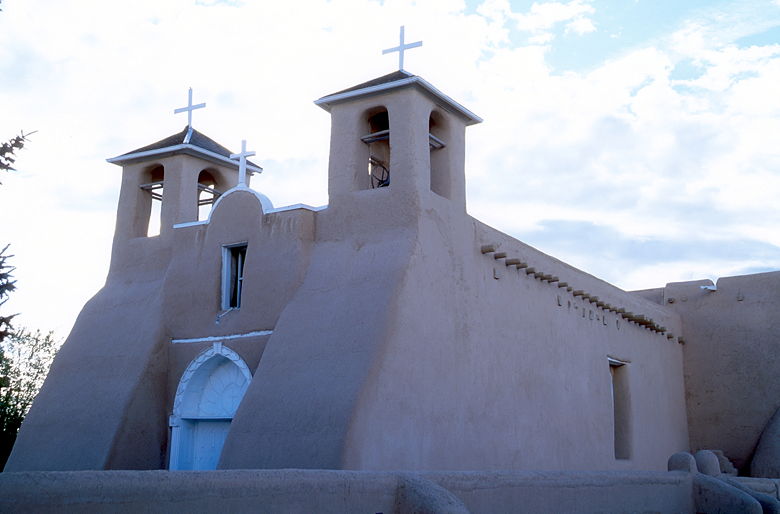
San Francisco de Asis Church
We had 7:30pm dinner reservations at Joseph's Table, but we arrived a bit early.
This wasn't a problem for them, however -- even on Mother's Day. Not to say the
restaurant wasn't busy. It was. It was also very good. We had white wine,
oysters, shrimp, salad with chopped nuts, crispy duck and fish. Their smashed
potatoes are especially tasty. My duck with pear chutney was excellent, as well.
Okay, everything was great. We topped it off with tea and dessert. Joseph
Wrede was named one of the top 10 new chefs in Food & Wine magazine. He did nothing
to dispel that notion tonight. Afterwards, Jean, perhaps having had a little too
much to drink, went into the kitchen and told them they were better than Gary Danko.
While I'm not sure about that, I would definitely return. And it's definitely
cheaper, too.
We took Highway 68 back, and quickly made it back to our suite in about 45 minutes.
As I said, 68 is the direct and much quicker route, but if you have the time,
definitely take the High Road.
|


















